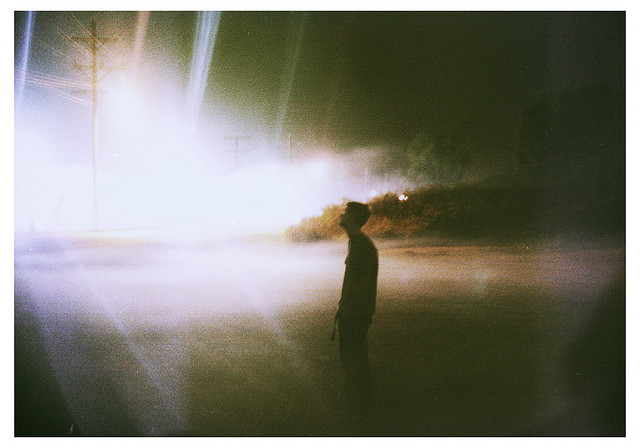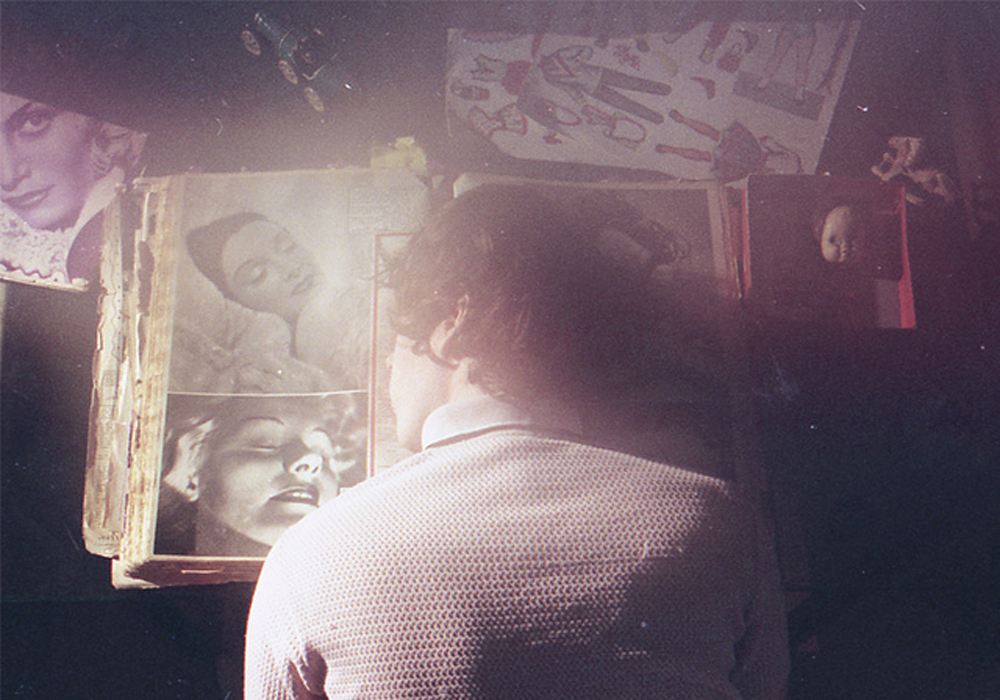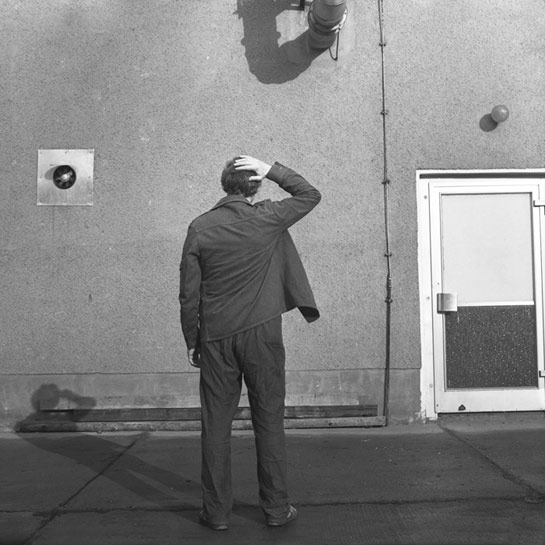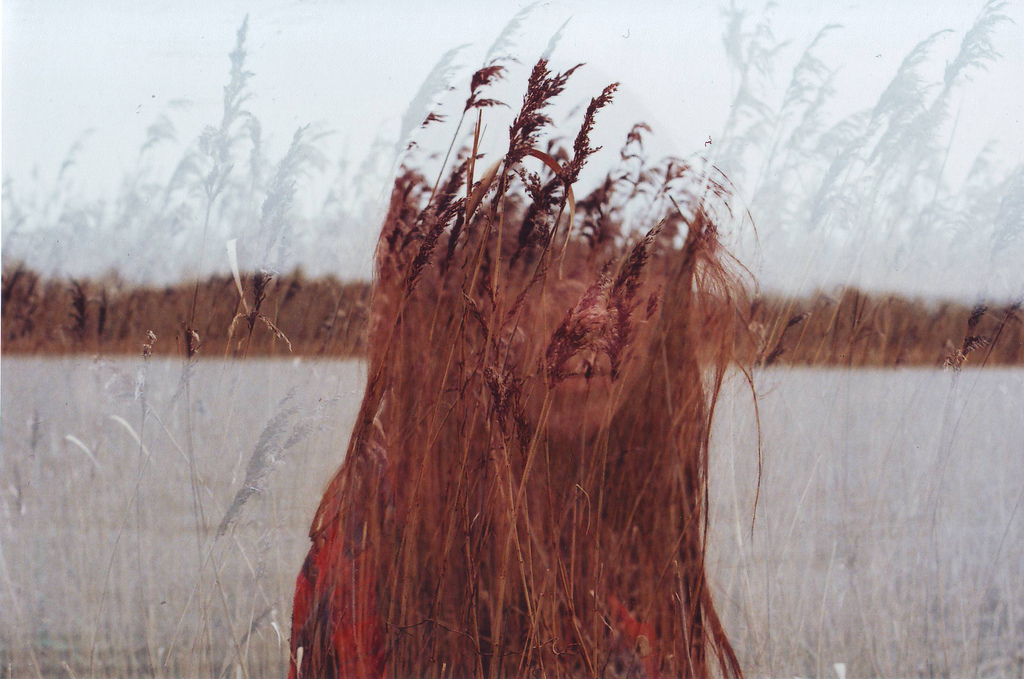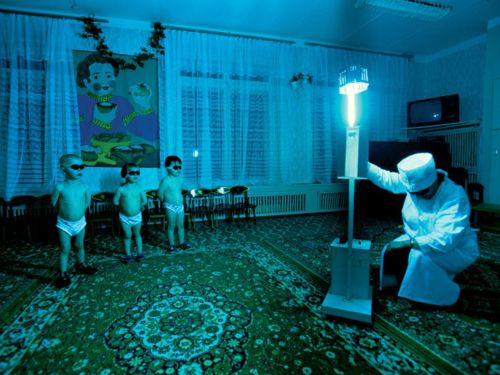Mike Hoolboom – Canadian Fringe Media Artist: an interview by Jitka Lanšperková (March 2017)
Published in dokrevue, Spring 2017
If we try to characterise Canadian author Mike Hoolboom as a filmmaker, we encounter a director who long ago freed himself from all restrictions and definitions associated with perception, projection, language, mechanical reproduction, sensation of the human body and bodily experience. His latest films focus on the concept of nationality and on nations as we define them. It is practically impossible to count his individual film titles, since Hoolboom often returns to his works and reworks, edits, cuts, re-edits or withdraws them from circulation. “I’ve decided to review my entire body of work. I’ve edited and republished many of my films, cut the biography of my pal Tom from 70 to 50 minutes, re-edited my feature movie Public Lighting (2004) and many others. Most are published on my Vimeo page. It is a form of recycling,” says Hoolboom describing his latest works.
“This year, I’ve finished a few things including Subway Stops, a feature-length installation of minute-long takes of faces of commuters travelling on the metro, Citizen Poet, a poetic commentary related to moments from a trek across Amsterdam and Geneva, and a colour trilogy that includes In 1974, Colour My World, and Identification.” The final part of the trilogy features black boys, a white bride, a landscape and dreamlike night vigils set in Toronto.
Hoolboom’s latest feature film We Make Couples looks at the issues related to the production of personal and production relationships, methods of opposing restrictions and ways in which we project ourselves onto other people. The film of almost an hour-long of running time, was premiered at the 20th Ji.hlava International Documentary Film Festival where Hoolboom has been a regular guest for several years. In fact, his work made in 2006 gave a name to the festival’s experimental section – Fascinations. Last year, Hoolboom’s shot a short film at the festival called Ghost, capturing the faces of the festival director, Marek Hovorka, and the programmer of the experimental film section, Andrea Slováková. In the following interview, Mike Hoolboom, with his own characteristic style of imagination, talks about the role played by experimental cinema in our era characterised by information overload, new trends in the generation of contemporary Canadian media artists and the relationship of the film media, reality and the truth.
Jitka: You said once that you look forward to the cinema everyday hoping you‘ll finally see a perfect movie. What do you expect this perfect movie offers to spectators?
Mike: John Cage was once asked this impossible question: what is your music about? He said that it was about getting out of a cage. Out of the cage of his name for instance. The prison house of language that might have begun with his own naming. He went on to say, ”I can’t understand why people are frightened of new ideas. I’m frightened of the old ones.” Aren’t we all held down by our convictions, and most of all, our allegiances to former versions of ourselves? One of the reasons I like to go to movies is that it allows me to jump into other people’s bodies. In the dark of the theatre, I feel what they might feel. This is a way of slipping out of the cage, particularly when this foreign cinema body reacts in unusual ways, or when that body belongs to a tree, or an earthworm, or a goat. What could be more perfect than to watch an hour-long movie about a tree as a prelude and primer to becoming a tree?
Jitka: For dok.revue in 2005 you wrote a piece about video and images which can now be produced and distributed by anyone with a phone and an internet connection. But the ease of production and speed of delivery can defeat the project of seeing. News stories often lack pictures that show, instead they produce pictures that conceal. You suggested that people are losing the ability to look, to see for themseles. What is the most effective way to observe the world around us?
Mike: We are always encountering one another through a frame. One of the most important things a movie artist can do is to make the frame visible. This is a documentary gesture, it clarifies and reveals, and expresses a certain solidarity with the audience. The broken frames and dirt and shifting time signatures and self-reflexive address assure the viewer: we’re all in this together!
How to look at the world? Our culture holds a special place for doers and makers and folks who can express themselves. Why are there no awards for listening? Or reading books? Or looking at something for a long time? How long did it take you to see your best friend’s face? I need to see my friends over and over again. I need to see them change, to encourage the shapeshiftings even, and this intimacy creates the roots for seeing. Seeing means that I have to open myself to be seen, to show even what I can’t bear. Seeing always means seeing together, it means that I am also visible, that both of us are naked at the same moment, opening together.
Jitka: In your film We Make Couples you examine the art of projection and the production of relationships. How is the film medium able to project reality and truth onto a screen? Can “reality“ be captured in an image?
Mike: Well, pictures are reality, and no one knows this better than someone who is in love. How did Lacan put it? Love means giving something you don’t have to someone who doesn’t want it. But the picture of desire is so strong, it glides over the annoying contradictions and disappointments, at least for a spell.
Humans have a long history of making pictures of what is human, and what isn’t human. For instance, in North America, blacks were considered not human. Therefore they could be slaves. In my country, the original Indigeneous people were not considered fully human, so they had to be exterminated, or re-educated, or jailed. To look at someone and consider them inhuman means living inside a picture, doesn’t it? And these pictures have very real consequences. Just ask Trayvon Martin’s family. Or every Palestinian trapped inside the open air prison of Gaza.
Jitka: How do you work with “reality“ and “truth“ in your images? Is it even possible to show reality in the movies?
Mike: This summer my father stepped into his last home, a seniors establishment where most are in wheelchairs, and his nearly speechless dementia is a commonplace. There is a painting at the end of his hallway that shows three toy boats in the water. Over and over again he stops at this picture, then draws his finger across the bottom of the frame, and then he traces the wall around the picture. When he arrived he was a voracious reader of detective novels, but words have become a foreign country, and even the pictures on television move too quickly for him to follow. Instead, he has taken refuge in this picture, which is more real for him than most of the faces he meets each day.
What never ceases to amaze me is how much memory he has lost, and yet he retains some version of the person i used to call father. Is that the picture behind the picture? Two years ago I was hit by a car and lost my memory. Because I had been a movie maker, the doctor had this strange and beautiful idea to have me make one-minute pictures and create a new archive of memories. These fragments became the basis of Incident Reports (70 minutes 2016), a feature-length movie that shows me meeting some of my old friends again for the first time. By reviewing their pictures again and again, they became familiar to me, as they once had been, and these memories found a place to live inside my body. When you use the words “truth“ or “reality“ I can only think: oh, you must mean the body.
Jitka: We Make Couples (60 minutes 2016) offers an intense immersion into intimacy itself. How can a film become an extension of intimacy?
Mike: This is the subject of my new short movie called Ghost (3 minutes 2017). It was shot during the closing ceremony of last year‘s Jihlava festival in the Dukla, far from the main action. Fest director Marek Havorka should be on the main stage, but instead he’s camped out on the fringe because his pal Andrea, also an integral fest organizer and programmer, is showing her movie. What an introduction he gave that night, with pressure mounting from every direction, the soul drain of all those late nights. He said: “People often ask me when I will start making films. Directing the fest already takes more time than I have. But Andrea is woman, she can make festival and movies!“
Moments before he finds these words he is crouched in the dark of the theatre while the trailers play, texting press missives that will appear in tomorrow’s newspapers. He is here, and not here, a shadow in the cinema. I’ve blown up his face so it is shattered into pixels, then laid an image of a projectionist behind him, as if he had dissolved into the stuff of movies. And then the camera lurches backwards, in recoil, and finds a tangled mass of colour and shape that snaps into focus and reveals the face of Andrea, lit by a computer glow, her features suddenly and starkly visible, but also ghostly, phantom-like.
On the soundtrack we hear an iconic scene from Godard’s Contempt. Bardot is asking her partner a brace of questions: do you love my hands? My shoulders? My ass? Yes, yes yes. After the movie’s producers saw the first cut of the movie they demanded that Godard shoot a nude scene with Bardot, so this is what he produced, a woman dishing herself in fragments, newly broken, a body in parts, de-composed, subject too long to the gaze of others, a gaze that ultimately has to do with money, or the way looking can be coverted into currency. Along with Georges Delerue’s dripping string score it is a heartbreaking quotation about love, fragmentation and capital. She wants intimacy but her body keeps getting in the way. He wants to love her, but someone else’s money keeps getting in the way.
This scene provides the glue for our own menage a trois – between Marek, Andrea and myself. Have we been too loyal to the cinema? Have our bodies become parts of the machine, the endless work we always seem to be voting for? My movie’s final image offers an enigmatic clue. It shows a tiger, a lean and athletic animal, only now it is frozen behind glass, stuffed in a window display. What was once vigorous and wild, wildness itself perhaps, has become an object to be looked at, even as it appears to be looking, keeping a vigil for its own statuary.
Jitka: Your work consists mainly of so-called “stolen footage“ but you also use your own film material. It refers to mediation and media reflection. What are the main reasons that you consider these methods (stolen footage, reconstructuring meanings, recontextualisation of images) important?
Mike: I’ve made many movies with and without stolen footage. But in both instances the archive is central. It’s a concern I share with most folks today, I think we have reorganized culture around the question of the archive. Our telephones and devices are portable archives, it seems archives are so newly important we can’t bear to leave home without them. Archives of pictures, sounds, names, addresses, numbers. Frederic Jameson offered us a picture to describe what he called “the postmodern condition.“ It’s a flatbed truck – you can load anything onto it. Once our trucks are loaded, and of course they are always filled to overflowing, it’s a question of how to sort the ruins. What is essential and what is a distraction? How can these fragments be reframed in order to give our lives meaning? The state is busily at work on this project as well of course, criminalizing segments of the unwanted population. Edward Snowden taught us that the premise of the surveillance state is to gather all information, about everyone, all the time. The largest archives of stolen footage belong to the state. It is up to artists to use these pictures and sounds in a different way, in order to resist. My movies offer a panorama of models for how to reimagine the archive.
Jitka: Almost ten years ago, you led a couple of workshops at Jihlava IDFF focused on Canadian experimental cinema. You introduced a mostly central-European audience to Canadian media artists such as Dani Leventhal, Aleesa Cohene, John Price, Jason Boughton, Mieke Bal and Jubal Brown. Do you see any dominant tendencies or styles in the makings of a new generation of fringe media makers in Canada?
Mike: Quick corrective note: Dani and Jason are American, Mieke is Dutch, though at home anywhere in the world. Hereabouts in Canada there has been a rapid escalation in the number of media artists. There are more Indigenous artists working than ever before, and surprise surprise, their work often features Indigenous folks and thematics. Many artists freely mix single-channel works with installations (reconfiguring projects to accomodate multi-screen gallery hopes). There is a dedicated scrum of film fetishists who are formally inclined, dreaming of form before content. They are accomodated, even encouraged by some of the local curatorial elites, and by the presence of a single film lab (Niagara Custom Lab) that is being run by a few overworking heroes, most notably Sylvain Chausée.
The art schools are stuffed with brown and black students, one can expect they will bring the heat in a few short years and change everything. But in the meantime spiralling real estate prices have turned Vancouver and Toronto into neo-liberal showcases. When I was starting to make movies I lived in a derelict east-end warehouse, like we all did. You could get by on a part time job then, but today everyone has a job or three. The exhibition climate is increasingly professionalized, and owing to the extravagant amount of work beng made, curators are the new royalty, and predictably this has meant that the work being championed is more conservative, less political, less sexual, less deviant, less experimental. We need to invent new forms of distribution and exhibition because the existing models are failing us. Somehow we have to take some of the ingenuity and out-of-the-box thinking that flows so easily into our makings, and apply it to the vexing question of how to show and share this work.
Jitka: Could you identify any new trends which have been formed in Canadian fringe media making in the last ten years when so many new digital technologies were presented?
Mike: Found footage is out, home-made and handmade is in. Because the computer is another way of expressing disgust towards our bodies (the mind is beautiful, but the body is a stain), of losing our bodies, we have learned to long for a cinema that can show us the markings of a body at work. I am thinking of Taravat Khalili’s quiet masterpiece Does the Sand Hear the Waves? (31 minutes 2016) in which she brings a camera into the domestic life of her family, often perched off-angle, as if she were a spy in the house of love, peering around corners, focussing and refocussing. Again and again she makes an approach, she walks towards a door, a threshold, and carries our bodies along with her. Here is a reminder of how difficult it is to learn how to shoot in this digital moment, when we need only point our devices in the direction of the action, instead of becoming part of it. Taravat holds the camera in her hands, and knits the movie together like her ancient grandmother in Tehran, stitch by stitch, year after year. She delivers us to an archaeology of exile, where home has become an impossible dream.
And then there is the work of my comrade Jorge Lozano. He makes another movie every few weeks, filled with lavish colours and sounds he produces by joyously screwing around in his digital playpen. Is there no end to his invention and imagination? The frame he brings to the work is important of course, as a person for whom English is a second-language, as a person of colour, as someone who retains a home in Colombia. As a result, he has x-ray vision when it comes to conditions of power, displacement, poverty. Even his formalist asides are imbued with the air of protest and opposition. He has just finished his masterpiece Illegal_its impact on the body (37 minutes 2017), following the lives of four people living illegally here in Toronto. He revisits the city as a hypnagogic daydream, filled with fantastical colours and canted perspectives, even as his quartet speak of power and privilege, and the lives of the invisible underclass that make the city run. It’s the most inspring work I’ve seen in years.
Jitka: Our world is overloaded by information, the profusion tends to be chaotic and people can be easily defeated by misinformation. What is the role of experimental film nowadays?
Mike: The hope of so-called structural film was that if we could look deeply enough into the processes of cinema — the machines, the chemistry, the conditions of production — we would find the entire project of capitalism in holographic miniature. The role of the movie artist was to intervene, throw a spanner into the works, reveal some of the hidden codes that bind us. It was a project that united radical form with radical content. It was aimed against capitalist hegemony, and was often produced in metropolitan undergrounds, left-over industrial remnants of the city, cheap outlying areas.
The question I hear you ask is: how is resistance possible? Or else let’s give up and add more to the genre pile, create footnotes, addendums, supplements to the Great Things that have already marked out the field. Motion picture resistance, or what we used to call counter-cinema, is taking many forms, but the most significant remains grounded in identity politics. While the first wave of experimentalisms were dominated by straight white boys, with now and then a fruitcake slinking through the door, the most important work being made today is by people of colour. For instance the work of Alexandra Gelis brings us the black eye of Rafael as he queens across a Panamanian laundromat, his chest open so that the wings of his words can lift every ordinary encounter into a queer sublime. In The House of Olga Alexandra dishes a portrait of a homeless woman who proudly tours us around the back end of a monastery where she has lain down to sleep for years. In Michael Keshane‘s Keepers of the Old People the artist appears in a first-person journey of fire and water, grieving his grandmother. Here are lives that will never appear on social or corporate media, and they require new forms to show us the way.
Jitka: For the 20th edition of Ji.hlava IDFF, you were asked this question: ”Will documentary film still be around in 20 years? And if so, in what form?” You replied: ”There will be no ‘directors’ any longer of course…” Who/what would direct/create future documentary and experimantal movies then?
Mike: Directors feel like a parental fantasy. Couldn’t someone take care of me? Show me what I should do, how to look, model behaviour, set the rules? It remains my hope that we will grow tired of our parental models, which are based on fear, though more than a few are vying to run countries round the world, many of them wrapped in their own flags, breathing fire about borders, and loudly declaiming about who belongs and who doesn’t. The cinema is an authoritarian form. It was necessary to do this collective dreaming, this coming together in public so that we could be alone. It produced a particular kind of consciousness, a particular kind of person. I think it’s related to mass production, industrial processes, the importantance of cities, and of course colonial expansion. Cinemas have already been shrunk to the size of a telephone, and in place of theatre chains we have the internet. The problem is finding each other. How can we find each other? And how can we put down our screens so that we can live inside each other’s breaths, each other’s bodies?
Jitka: Where is the future of screening/showing/presenting for experimental films? Is it cinema, festival, gallery, museums, DIY screenings, private screenings?
Mike: Would it be ok for Mr. Derrida to answer your question about the future? Jacques Derrida: “In general, I try and distinguish between what one calls the Future and “l’avenir” [the ‘to come’]. The future is that which – tomorrow, later, next century – will be. There is a future which is predictable, programmed, scheduled, foreseeable. But there is a future, l’avenir (to come) which refers to someone who comes whose arrival is totally unexpected. For me, that is the real future. That which is totally unpredictable. The Other who comes without my being able to anticipate their arrival. So if there is a real future, beyond the other known future, it is l’avenir in that it is the coming of the Other when I am completely unable to foresee their arrival.”
Jitka: In which moment is a film formed and actually starts to exist? When you touch celluloid for the first time, or the first time it is actually screened and watched by audience?
Mike: Cinema is relationship. Movies wouldn’t exist if no one were around to make or receive them. They change over time, even physically, and the ways we can receive them also shift. Though I am recalling a joke of a performance offered at a long ago open screening by Peter Chapman who picked a reel from the projection booth, walked it to the front of our home-made theatre, held it up and announced, ”This is the film that I am showing.”
Most of us have had a formative experience with movies. There is a movie, or set of movies, after which nothing was the same. Your sexuality, the way you sit in a chair, the way you hold your face. This primal experience, this turning point, is the trigger, the anchor even, for further experiences, though nothing might ever glow as bright. That moment of connection, between a movie and its viewer, is when cinema is alive. Many movies are dead, or time fillers, or place holders. They are like the waiting room in a doctor’s office, of course they’re necessary, but the healing doesn’t happen there.
Jitka: Do you use scripts? What do they look like and what does a scripting process mean for fringe media?
Mike: I usually write scripts after the rest of the movie is finished. For Incident Reports I steadily gathered one-minute shots, and even put them together before I was told that further explanations were required. Why is each shot one minute? Why are these pictures being made? I thought the story of the pictures was visible in the images, but that was only because I’d seen them hundreds, even thousands of times. The same is true for Scrapbook, I thought it was enough to show the stunning black-and-white images made in an American residential mental health hospital in the sixties by my friend Jeffrey Paull. I simply added some ambient music to make them go down a little smoother. But my go-to feedback pals assured me the movie had no meaning at all, so I contacted one of the people in the movie, had her watch it, and recorded what she said. This became, not exactly the script, but the text that floats over the pictures.
Jitka: Where is the future of screening/showing/presenting for experimental films? Is it cinema, festival, gallery, muzeums, DIY screenings, private screenings?
Mike: Yes.
Jitka: According to your website it seems you are currently working on at least nine (mainly) short movies. Will all of them be finished this year?
Mike: Oh yes. I’m not sure what happened. The jailor took a vacation, the need to be forever starting again, to go over and over a piece of work searching for the thread that will unravel the whole project, the ceaseless grind of re-editing seems to have been temporarily stalled. I‘ve decided to revise my entire body of work by the way. I’ve already re-cut and re-released quite a number of movies, shortening my bio of experimental film pal Tom from 70 minutes to 50 minutes, majorly re-editing the feature-length Public Lighting, and many others. They’re all going up on my Vimeo channel. It’s a form of recycling.
Jitka: What are your new movies about?
Mike: There is a trilogy of movies about colour: In 1974, Colour My World and Identification. In 1974 shows 15 colour film tests made by Film Ferrania in the seventies, each fades into a dominant colour, as if the world was becoming “pure” colour. It closes with an American cop assaulting a woman in a convenience store while the screen glows red. Clearly, she has been targetted because of her colour. The movie asks: how have you learned to see colour? Colour My World was made by soaking a roll of super 8 film in water for a few years. Much of the emulsion washed away, all that is left are coloured fragments. A series of texs scroll across the abstract remains. They make an inquiry into “seeing colour,” and the movie closes with the question: “Is the screen a mirror or a door/where we can discover/what we are not yet?”
Identification was begun during a residency in East Lansing, Michigan in the US last fall. I was in the middle of a breakdown, though overworking seemed to help. In the face of ongoing revelations about persistent sexual assaults at American universities, the students and I opened discussions about where they felt safe, and asked questions about colour, identity and privilege. While they made personal movies in the workshop, a couple of them took me around East Lansing. One lay on the ground as if dead (another black martyr) in a variety of locations. Another moved through a series of spaces, including an abandoned school and the state legislature. I threaded these shots with new shootings here in Toronto that showed black pals hanging out, a bride floating past, landscapes and dreamy nighttime vigils. It closes with a cell phone recording of Charlie “Africa” Keunang’s death at the hands of the Los Angeles police, while we watch a man named Tooth absorb a multi-coloured light, as if he had entered an after-death bardo state.
Subway Stops is a feature-length installation made of one-minute shots of people’s faces as they ride the subway. Most are seated and look directly into the camera. There are 69 faces, one for each subway stop. It is about our public face, about looking and being looked at, a serial portrait made in the in-between space of the underground, neither here nor there, on the way to becoming.
From the Archives of the Red Cross was begun in a three-week seminar at the Geneva University of Art and Design (HEAD) in October 2016, seventeen of us began an excavation together, immersing ourselves in a selection of Red Cross shorts made over nearly a century in countries round the world. This nearly wordless feature-length ensemble has five parts/chapters: The Man Who Stopped Time (Greece), Disappearances (Switzerland), Photo Shoot Location Yemen (Yemen), Beirut Grammar (Lebanon) and Mine Clearing (Mozambique). Each chapter adopts a different formal strategy in order to open up a new conversation with these picture remains, sometimes scribbling over the pictures, or re-presenting the material as a series of friezes, fading every shot, or slowly accumulating them. The hope is time travel, to venture to the other side of the image.
Introduction to Mountains was made at the request of an Italian fest that wanted a short video intro. I shot in my bathtub, under failing and flickering lights through a greasy curtain, dishing a text that borrows from Zen maestro Dogen’s Mountains and Rivers Sutra.
Citizen Poet features a collection of moments gathered in Amsterdam and Geneva during the fall trek last year. It is inspired by the poetry of Lisa Robertson and the work of Hardt/Negri. They argue that poetry is the language of citizenship. The wandering pics and intimate moments go along for the ride, accompaniment and counterpart. Lisa Robertson: “It is in the history of poetry/ that we have a record /of subjectivity’s movement in language.”
